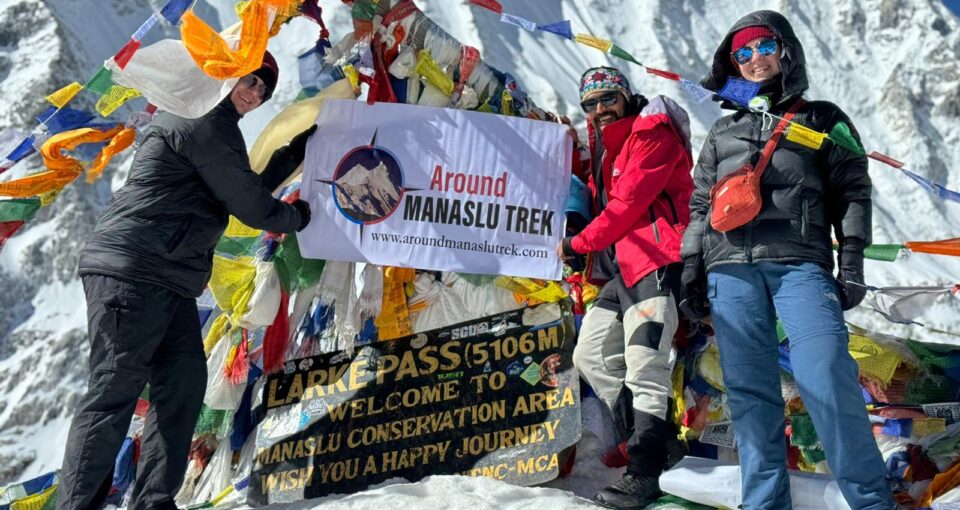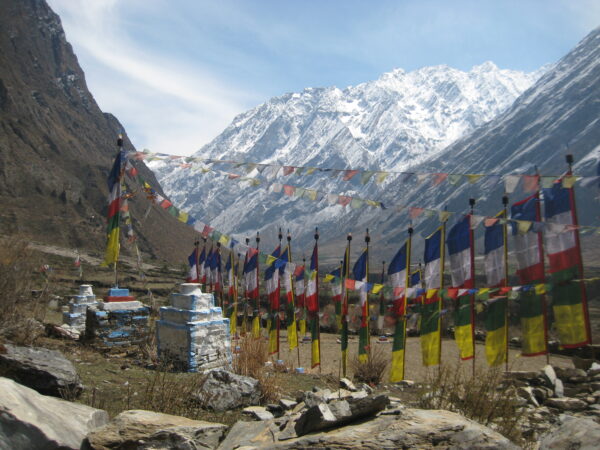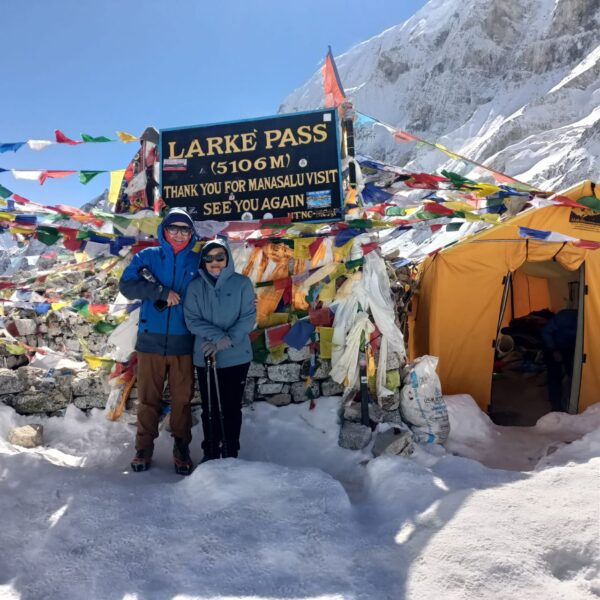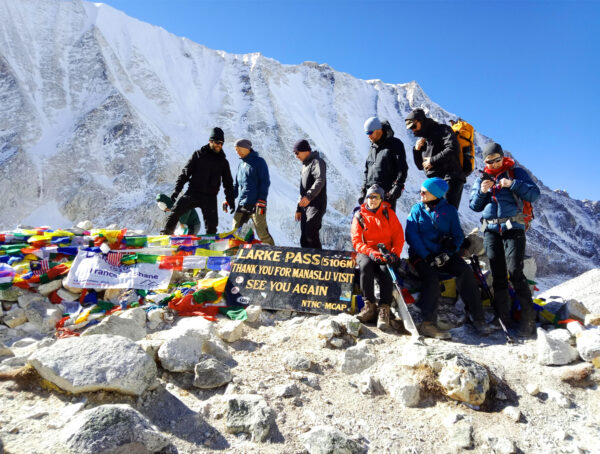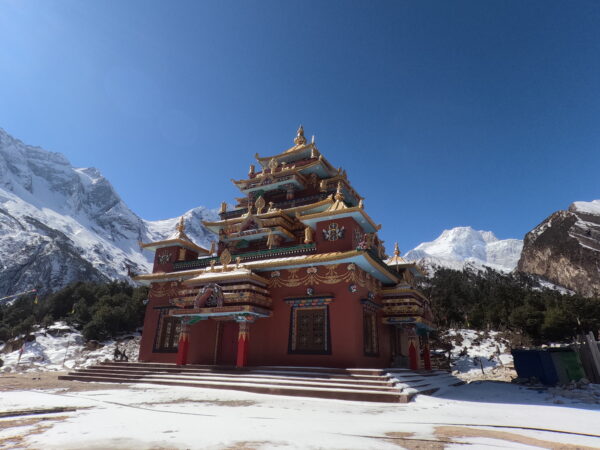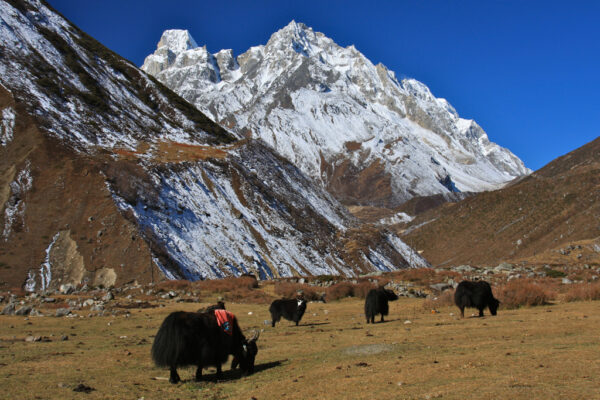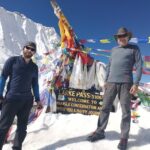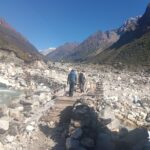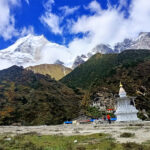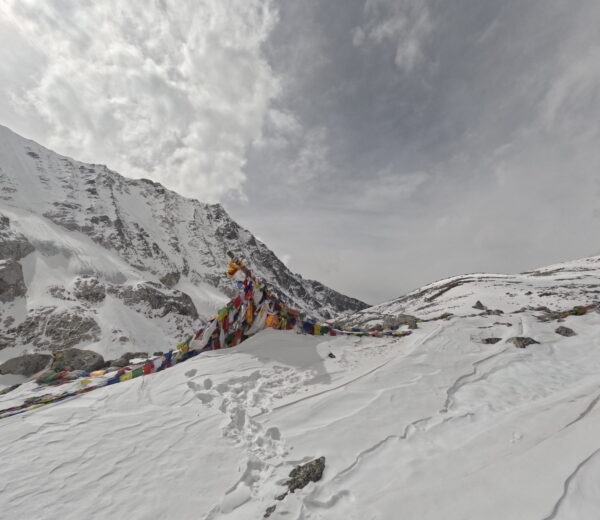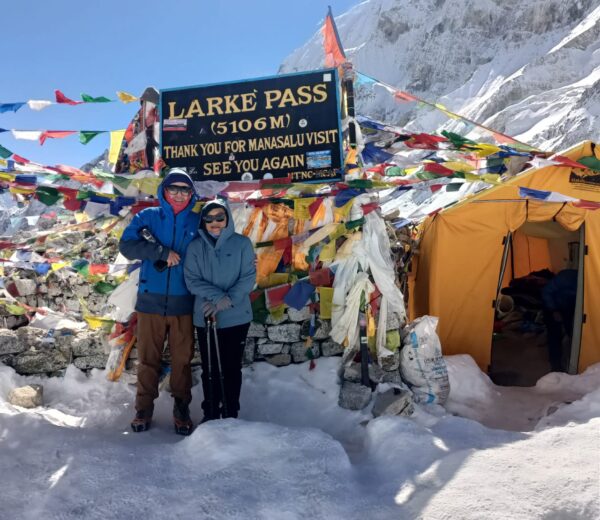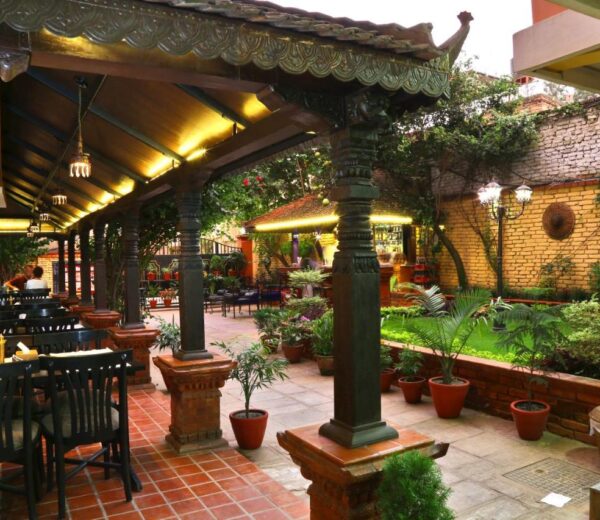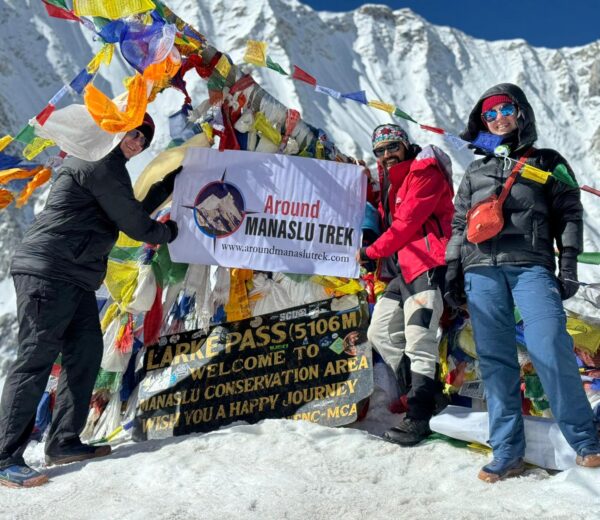The Manaslu Circuit Trek is one of the best teahouse trails in Nepal; it stands out for its unique blend of culture, with a strong influence of Buddhism, and its picturesque teahouse trail. It is an off-the-beaten-path trek, circles the majestic Mount Manaslu crossing the challenging Larkya La Pass at an altitude of 5,106 meters, provides stunning views, diverse landscapes, and cultural insights. Lasting 12 days, the Manaslu Circuit Trek ranks among the most captivating and sought-after trekking routes in Nepal, trailing closely behind the Everest Base Camp and Annapurna Base Camp treks in popularity.
Manaslu is a popular remote area located in the central west part of the Himalayas in Nepal. It reckons in the sub-tropical Himalayan foothill to dried Trans-Himalaya high meadow bordering Tibet, China. The elevation of its sub-tropical zone varies from 1000 meters to 2000 meters; whereas the sub-alpine zone ranges from 3000 meters to 4000 meters. Its zone above 4500 meters is called an arctic zone.
Historical Access Restrictions: The Manaslu region was closed to foreigners until 1991. Although it is now a popular tea-house trekking route, certain areas remain restricted or controlled zones, requiring special permits for foreign visitors.
Thrilling Adventure at Larkya La Pass: Exploring Nepal’s Manaslu Circuit Trek
Throughout the Manaslu Circuit Trek, Larkya La Pass at 5,106 meters stands out as the most challenging and thrilling high pass in Nepal’s Himalayas. At its summit, trekkers are treated to breathtaking views of Manaslu, Manaslu North, Samdo Peak, Naike Peak, Larkya Peak, and Cheo Himal. The pass lies between Dharmasala and Bimtang, marking the highest point of the trek. In winter, heavy snowfall can make crossing Larkya La Pass difficult, often blocking the trail near the summit.
We, the Around Manaslu Trek, with our local crew and experienced team, specializes in leading treks throughout the Himalayas. Offering various multi-package treks in the Manaslu region for 2025 and 2026, we customize trek itineraries based on preferences and holiday duration. With licensed local guides from the Manaslu region, our high success rate ensures safety and enjoyment, even under challenging conditions. This restricted trekking journey promises unparalleled scenery, including the majestic Mt. Manaslu (8,163m), the world’s eighth highest peak, making it an ideal choice for those seeking tranquility, wilderness, and cultural immersion amidst Nepal’s rural landscapes.
Mount Manaslu: Nepal’s Eighth Highest Peak
Mount Manaslu, located on the border between Nepal’s Gorkha and Manang districts, stands 64 km east of Annapurna. This majestic peak, named after the Sanskrit word “Manasa” meaning “Mountain of the Spirit,” reaches a height of 8,163 meters. It is one of the world’s 14 peaks over 8,000 meters, with Manaslu being notable for its historical significance in mountaineering.
Historical Significance and First Ascent of Mount Manaslu
Mount Manaslu was first summited by a Japanese expedition in 1956. The early climbing attempts began with the Japanese Manaslu Reconnaissance Expedition in 1952, which explored the mountain when it was still unclimbed. In 1953, a climbing team reached 7,750 meters but had to turn back.
The 1954 expedition faced resistance from the local inhabitants of Samu village, who believed the mountain was sacred and would bring misfortune. This led the climbers to redirect their efforts towards Ganesh Himal. After diplomatic efforts by the Nepalese government, the 1956 Japanese expedition, led by the experienced Yuko Maki and including climbers such as Katsuro Ohara and Toshio Imanishi, successfully reached the summit. This team made history by being the first Asian expedition to summit an eight-thousander.
On May 9, 1956, Imanishi and Gyaltsen reached the summit, offering breathtaking views of Ganesh Himal, Annapurna, Dhaulagiri, and Machhapuchhare. Two days later, Kato and Higeta followed suit. The first Nepali national to climb Mount Manaslu was Urkien Tshering Sherpa, who reached the peak on April 22, 1973.
Manaslu Trekking Route
The renowned Manaslu trekking route circumnavigates the Manaslu massif, crossing high passes and descending towards Annapurna. This trek follows the historic salt-trade route along the Budhi Gandaki River, providing a scenic and culturally rich adventure.
Trip Facts
| Starts from | Machha Khola | Ends at: | Dharapani |
| Trek Region: | Manaslu Region | Duration: | 15 Days |
| Trip Grade: | Moderate | Max Altitude: | 5106m |
| Accommodation: | Teahouse | Meals: | Breakfast, Lunch and Dinner |
| Best season: | March to May and September to November |
Manaslu Circuit Trek Highlights
- Stunning Mountain Views: The trek provides awe-inspiring views of Mt. Manaslu, the eighth highest mountain in the world, along with other towering peaks like Himalchuli, Ganesh Himal, and others.
- Rich Cultural Experience: Encounter diverse ethnic communities such as the Gurungs, Nubri, Tsum, and Bhutias, each with their own distinct traditions, architecture, and way of life. Explore ancient monasteries, chortens, and prayer flags that dot the landscape.
- Tsum Valley: Visit the secluded Tsum Valley, known for its ancient Buddhist monasteries, pristine landscapes, and the warm hospitality of its inhabitants.
- Larkya La Pass: Challenge yourself with a crossing of the Larkya La Pass at 5,106 meters, offering breathtaking panoramic views of the surrounding peaks and valleys.
- Tea House Experience: Enjoy the unique opportunity to stay in traditional teahouses along the trail, offering a glimpse into the local way of life.
- Off-the-Beaten-Path: Experience the tranquility of a less crowded trekking route compared to other popular treks in Nepal, providing a sense of solitude and adventure.
- Natural Beauty: Immerse yourself in the stunning landscapes of the Manaslu region, including lush forests, terraced fields, and pristine rivers and waterfalls.
- Wildlife: Spot various wildlife species such as the elusive snow leopard, Himalayan tahr, blue sheep, and a variety of bird species in the region’s conservation areas.
Why to trek Manaslu Circuit
The Manaslu Circuit Trek offers a wealth of experiences and surpasses other trekking regions in Nepal with its diverse elements. Key features include:
- Cultural Richness: The trek showcases Buddhist culture, enriched by the presence of the Nubri, Tsum, Bhutia, and Gurung ethnic groups, who have resided in the region for over 700 years. Their culture closely resembles Tibetan culture. The region is dotted with significant Buddhist sites like Pungen Gompa, Mu Gompa, and Syala Gompa.
- Natural Wonders: The trek passes through diverse wildlife habitats, verdant forests, and across raging rivers via suspension bridges, all set against the backdrop of a breathtaking necklace of mountains.
- Manaslu Conservation Area: Covering 1663 square kilometers, this area was declared a conservation area in 1998. It is home to:
- Endangered species such as red pandas, snow leopards, Himalayan tahr, Asian black bears, Himalayan musk deer, and blue sheep.
- More than 110 bird species, 35 mammals, and 3 reptiles.
- The Himalayan honey bee (Apis laboriosa), known for producing Mad Honey and being the world’s largest honey bee.
These elements make the Manaslu Circuit Trek an exceptional journey, offering an unparalleled mix of cultural immersion, natural beauty, and wildlife diversity.
Outline Itinerary
| Days | Day-to-Day Itinerary | Elevation in meter | Trekking hour per day |
| 1 | Arrival in Kathmandu airport and transfer to hotel | 1350m | |
| 2 | Trek Preparation Day and Half Day sightseeing Kathmandu Valley | 1350m | 4 hours tour |
| 3 | Kathmandu to Machha Khola | 710 m | 7 – 8 hours drive |
| 4 | Machha Khola to Jagat | 1410 m | 5 – 6 hours trek |
| 5 | Jagat to Deng | 1805 m | 6 – 7 hours trek |
| 6 | Deng to Namrung | 2630 m | 7 – 8 hours trek |
| 7 | Namrung to Samagaon | 2100 m | 6 – 7 hours trek |
| 8 | Rest day in Samagaon and a side trip to Manaslu Base Camp | 3530 m | |
| 9 | Samagaon to Samdo | 3860 | 4 – 5 hours trek |
| 10 | Acclimatization day at Samdo and visit to Tibetan border | 3860 m | |
| 11 | Samdo to Dharmasala | 4460 m | 4 – 5 hours trek |
| 12 | Dharmasala to Bimtang via Larkya La (5120 m) | 3700 m | 8 – 9 hours trek |
| 13 | Bimtang to Dharapani | 1700 m | 5 – 6 hours trek |
| 14 | Dharapani to Kathmandu | 1080 m | 7-8 hours drive |
| 15 | Final Departure / drop off to airport |
Detailed Itinerary of Manaslu Circuit Trek
Day 01Arrival in Kathmandu and Transfer to the Hotel
Upon your arrival at Tribhuvan International Airport (TIA) in Kathmandu, you will be greeted by one of our representatives and transferred to the hotel.
Day 02 Trek preparation day and half day sightseeing in Kathmandu Valley
Today is a mix of getting ready for your adventure and soaking in a bit of Kathmandu’s charm. Start your morning by organizing everything for the trek—double-check your gear, ensure your permits are sorted, and have a quick chat with your guide to go over the plan.
Once that’s done, take some time to explore the vibrant culture of the Kathmandu Valley. Visit iconic landmarks like Swayambhunath Stupa (Monkey Temple) for its stunning views and spiritual ambiance or head to Pashupatinath Temple to experience its profound cultural significance.
Use the rest of the day to relax, soak in the city’s atmosphere, and prepare for the journey ahead.
Day 03 Drive from Kathmandu to Machha Khola (710 m / 2,362 feet)
Our journey begins with a scenic drive from Kathmandu, winding through lush green landscapes and terraced hillsides that characterize Nepal’s beautiful hill region. We’ll follow the Trishuli River’s banks, enjoying glimpses of traditional villages, riverside views, and glimpses of mountain vistas in the distance. As we pass Benighat, we enter rural Nepal, driving toward the charming town of Aarughat and onward to Soti Khola. The final stretch takes us along a rugged road to Machha Khola, our destination for the night. It’s a full-day drive, filled with diverse landscapes and a perfect introduction to the adventure ahead.
Drive from Kathmandu to Machha Khola: Highlights & Estimated Timings
- 6:00 AM – Departure from Kathmandu: Begin your journey in the early morning, leaving the lively streets of Kathmandu as the city slowly awakens. The crisp morning air sets the tone for a scenic and memorable drive.
- 9:00 AM – Riverside Drive Along the Trishuli: Enjoy a serene drive alongside the Trishuli River, where lush hillsides and peaceful riverside views offer a beautiful backdrop for the journey. The winding road reveals Nepal’s stunning countryside at every turn.
- 11:30 AM – Lunch Stop at Dhading Besi: Pause for lunch in the bustling town of Dhading Besi. Take the opportunity to sample local dishes and immerse yourself in the flavors and lively atmosphere of this vibrant town.
- 2:30 PM – Passing Through Arughat Bazaar: Continue on to Arughat Bazaar, a lively trading post filled with local vendors, markets, and a glimpse into daily life in the hills. The vibrant scene here is a fascinating part of the journey.
- 5:00 PM – Arrival at Machha Khola: Arrive at the tranquil village of Machha Khola, set alongside the Budi Gandaki River. The peaceful surroundings mark the end of the day’s journey, offering a perfect spot to relax and prepare for the trek ahead.
Note: Timings are approximate and may vary due to road and traffic conditions.
Day 04 Machha Khola to Jagat (1370m / 4494feet)
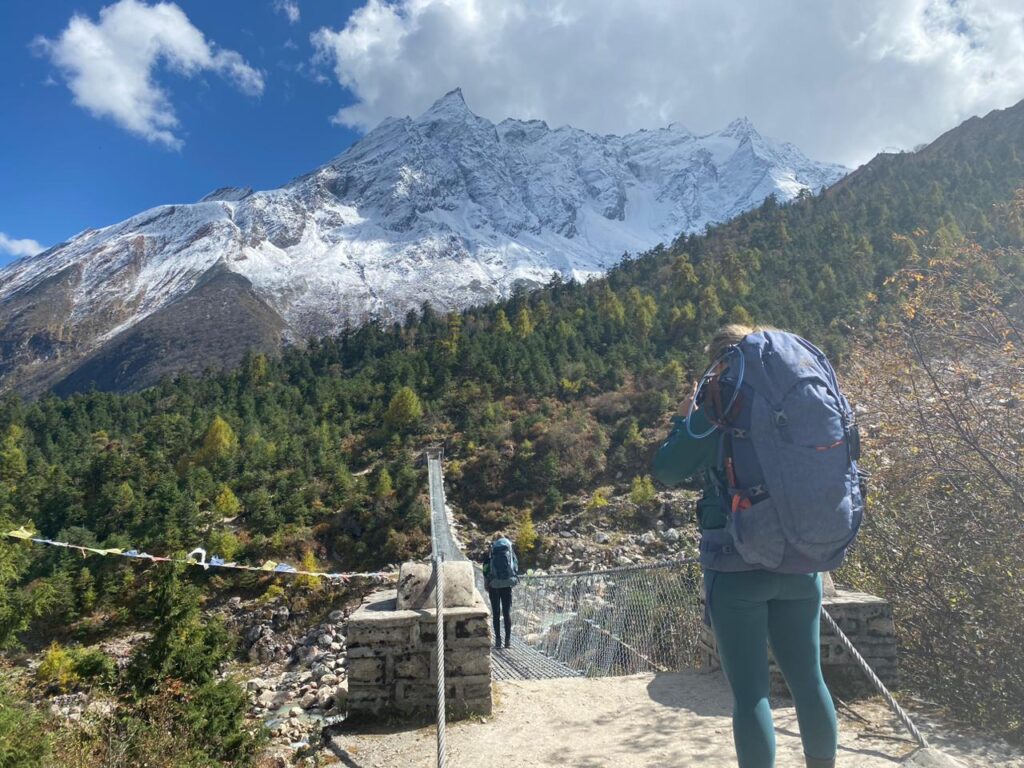
After beginning the wonderful trek to Machha Khola, the trek then moves toward Jagat village leaving behind Tatopani and Dobhan villages. In between Machha Khola and Dobhan, there is a traditional Gurung village called Khorla Besi. On reaching Tatopani i.e hot water, you can take a warm bath and relax for a while. The trek continues following the bank of the Budhigandaki River and crosses a suspension bridge just to arrive at Dobhan. The Nepali meaning of Dobhan is the interflow of two rivers. Following the waves, you can see the river getting flattened at Yaru village where you need to cross a long cantilever suspension bridge to reach Jagat. Jagat – a Gurung village where you will see a checkpoint to verify the entry permits of the trekkers. From today, you are entering the restricted area.
Day 05 Jagat to Deng (1,804m / 5920 feet)
The very next day, the trek ascends to Salleri and descends to Sirdibas. Then the valley widens and reaches the Ghatte Khola River. Meanwhile, you will be blessed with several prayer flags and gompas. There are some stop points where you can get local alcohol to try. However, it’s all up to you whether you want to try it or not. On the trail, you will encounter beautiful rhododendron forests, hanging cliffs, and towering peaks which are the highlights of the trail.
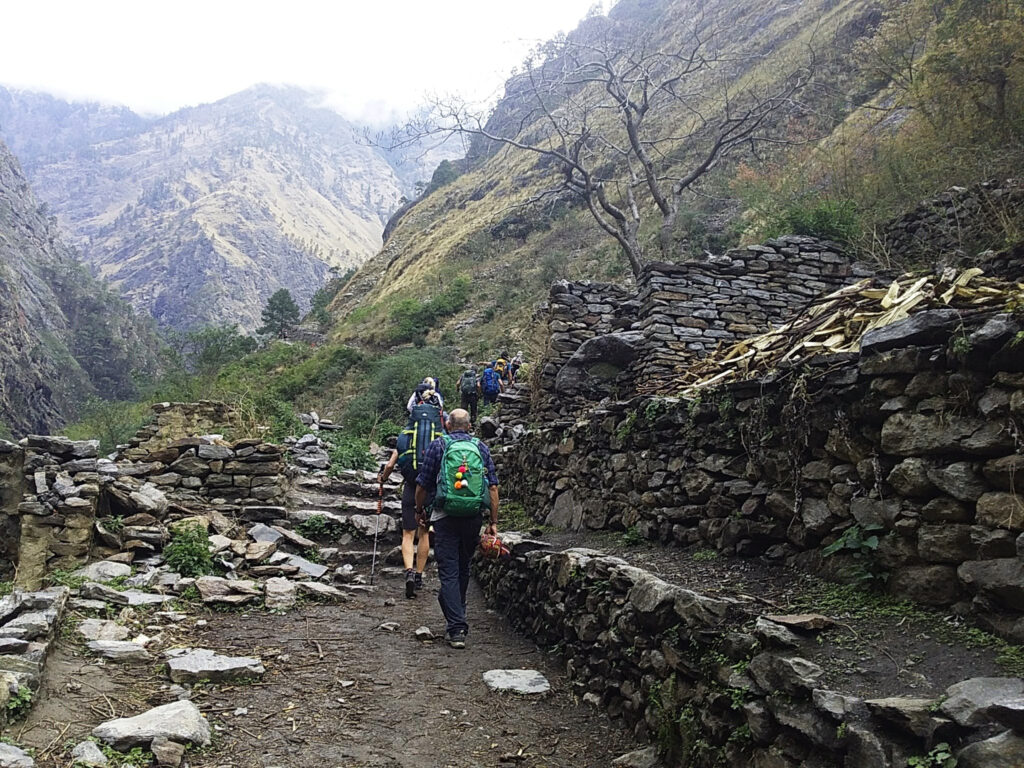
The trail continues walking upstream to a suspension bridge and reaches Philim – a Gurung village, and crosses the millet fields to the village of Ekle Bhatti. After a few minutes’ walk, the trail makes an entry to grassy slopes and crosses the Budhi Gandaki River. After that, trekking along the west bank for a while and crossing the east bank, you then return to the west side to follow the trail. Now, the trail widens and you pass through bamboo forests to Deng Khola and reach Deng village.
Day 06 Deng to Namrung (2,630m / 8628feet)
After having breakfast in Deng, you then further start your trek. This is one of the important days of the trek which you will be experiencing. First, cross a suspension bridge over the Budhi Gandaki River, and climb a ridge of Rana and Bihi Phedi. Now you will be passing through Lush forests and ethnic communities of the Manaslu region. Meanwhile, some beautiful peaks begin to appear in distance.
Today, you will be heading toward Prok which is a beautiful vintage point for the astounding view of snowcapped Siringi Mountain. Along the way, you will pass through several Gompas and crosses the Budhi Gandaki River. And the trail follows dense forests which reside inside the Manaslu Conservation Area, then you take a last steep climb to reach Namrung village.
Day 07 Namrung to Samagaon (3,530m / 11581 feet)
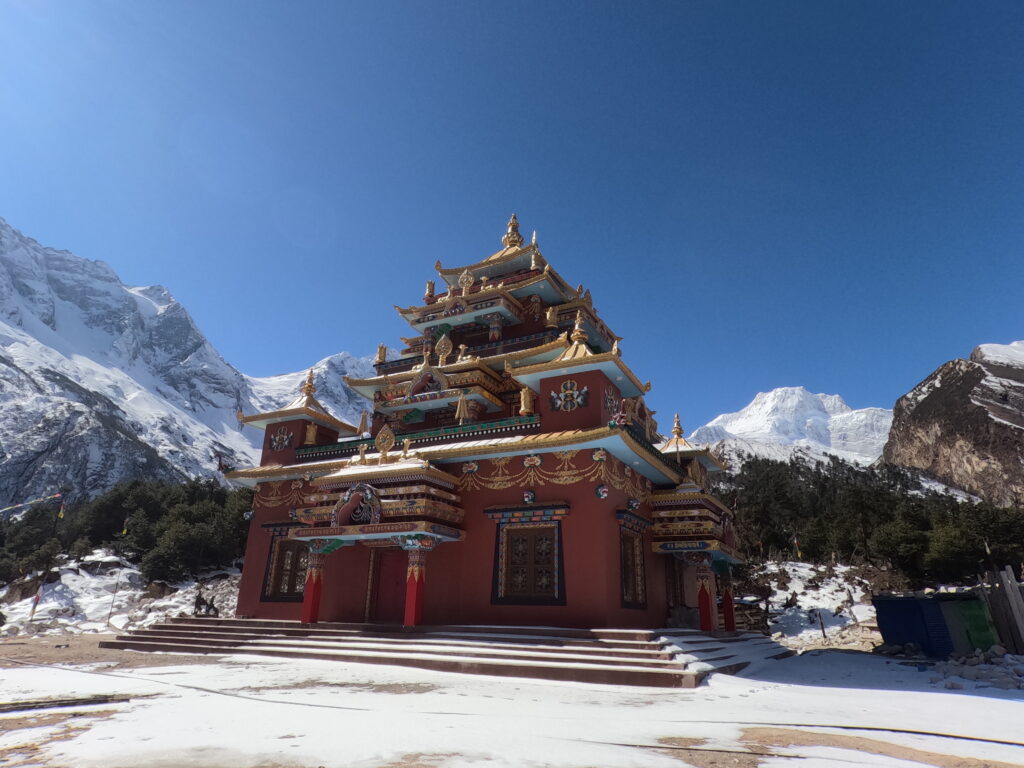
Today in the morning after having breakfast, you may like to walk around Namrung and get the best view of Siringi Himal, Ganesh Himal, and Himchuli. After that, you will pass through a few beautiful small villages like Lhi. Lhi is a beautiful small village having many stupas and barley terraces. In this area, you will get to witness the lifestyles of the Nubri people and explore the Tibetan lifestyle and cultures while passing through several mani walls, and lush terraces before entering Fir. You then encounter rhododendron and oak forest in between Lhi, Sho, and Shyala villages before reaching Samagaon. You will notice the amazing scenery of Mt Manaslu from Lho.
Day 08 Rest in Samagaon (Side trip to Manaslu Base Camp)
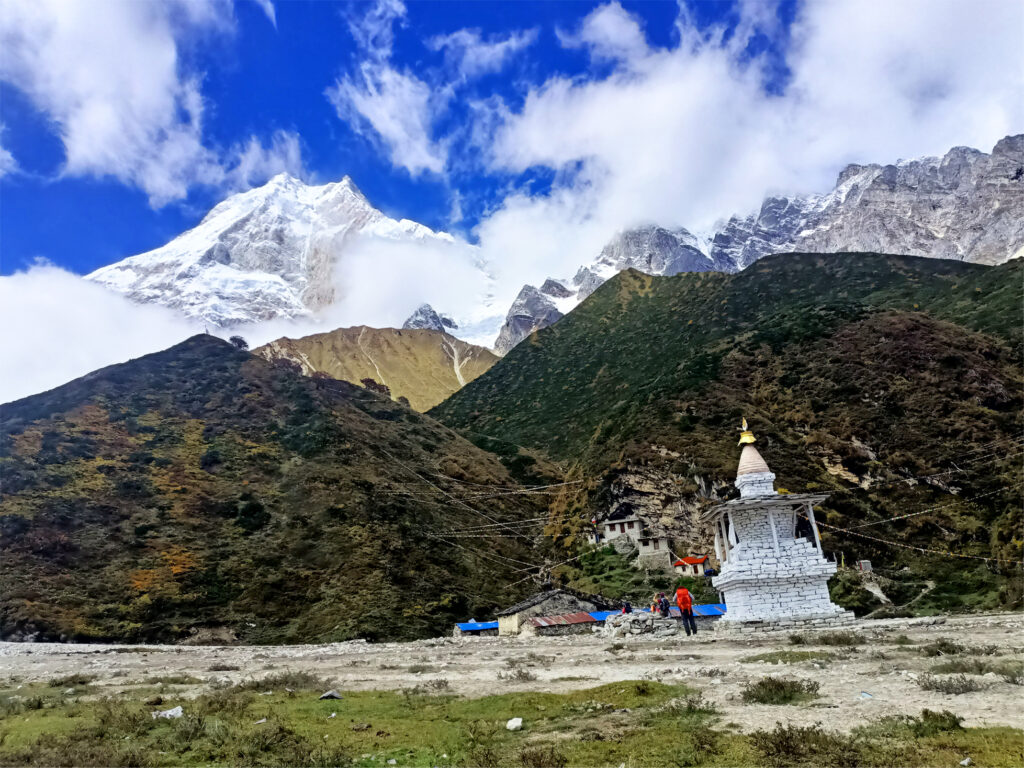
Begin your day with a nutritious breakfast at your teahouse in Samagaon. Prepare for the day’s side trip by packing essentials such as water, snacks, extra layers, sunscreen, and a hat. Set out on the hike towards Manaslu Base Camp, starting on a trail that offers spectacular views of the surrounding landscapes.
As you ascend, take regular short rest breaks to hydrate and enjoy snacks while appreciating the breathtaking scenery. The hike to Manaslu Base Camp involves a steady climb and can take several hours, so pace yourself and enjoy the journey.
Upon reaching Manaslu Base Camp at around 4,800 meters (15,748 feet), take time to marvel at the stunning views of Mount Manaslu and the surrounding peaks. This is an excellent opportunity for photos, rest, and hydration before beginning the descent.
Start your return hike to Samagaon, taking your time to safely navigate the trail and soak in the panoramic views on the way down. Once back in Samagaon, enjoy a well-deserved lunch at your teahouse.
In the afternoon, explore Samagaon village. Visit the Pungyen Monastery, interact with locals, and learn about their Tibetan-influenced culture and traditions. Take a gentle walk around the village to further aid acclimatization and appreciate the peaceful surroundings.
- Acclimatization day
- Have a refreshing breakfast and spend the day around Samagaon
- You can take a small hike on a little hill near Sama Village where you will find an old gompa called Pungyen Gompa while you may explore Sherpa culture and witness thousands of mani stones with a Buddhist text.
Day 09 Samagaon to Samdo (3,875m / 12713 feet)
- Descend to the Budhi Gandaki river and follow the bridge over the side stream
- Pass through several mani walls and get an amazing view of the mountain
- Get closer to the Tibetan border
- After reaching Samdo, explore nearby villages and hike to Samdo Peak. You can find the Larkya trail on the left side above the valley
Day 10 Acclimatization day at Samdo and visit to Tibetan border
Start your day with a hearty breakfast at your teahouse in Samdo. Prepare for the day’s adventure by packing essentials such as water, snacks, extra layers, sunscreen, and a hat. Begin your hike towards the Tibetan border, following a trail that gradually ascends and offers stunning views of mountains, valleys, and the Syacha Glacier.
Take a short rest break along the way to hydrate and enjoy a snack while soaking in the majestic views. Continue your hike, ascending steadily towards the border. Reach the Tibetan border at around 4,800 meters (15,748 feet), and spend some time appreciating the panoramic views and the unique experience of being so close to Tibet. Take photos, rest, and hydrate before starting your descent.
Carefully make your way back to Samdo, taking in the beautiful scenery along the way. Arrive back at your teahouse and enjoy a well-deserved lunch. After lunch, explore Samdo village, visiting the local monastery and interacting with villagers to learn about their Tibetan culture and traditions. Take a leisurely stroll around the village, enjoying the tranquil atmosphere and beautiful surroundings.
If you’re feeling up to it, take a gentle walk around the outskirts of the village for additional acclimatization, or simply relax at the teahouse and savor the views. End your day with a nourishing dinner, sharing experiences with fellow trekkers and guides. Spend the evening hydrating and relaxing, ensuring you’re well-rested for the next day’s trek.
Day 11 Samdo to Dharmasala (4,460m / 14632 feet)
Today’s trek brings us to Larkya Phedi, also known as Dharmasala, at an altitude of 4,600 meters. We start with a visit to the peaceful village of Samdo, where we pause to take in the unique culture and surroundings. After crossing an icy stream, we enter a starkly beautiful, drier landscape, with the high-altitude terrain gradually changing to rocky, barren slopes. Although the trek today is moderate, the altitude gain is significant, so we’ll move at a relaxed pace to allow for acclimatization. Arriving at Larkya Phedi by midday, we have the afternoon free to rest and explore. For better acclimatization, we recommend a short hike, ascending around 200 meters from Dharmasala, to prepare for the crossing of Larkya La Pass the following day.
Day 12 Dharmasala to Bhimtang (3590m / 11778 feet) via Larkya La (5160 m / 16929 feet)
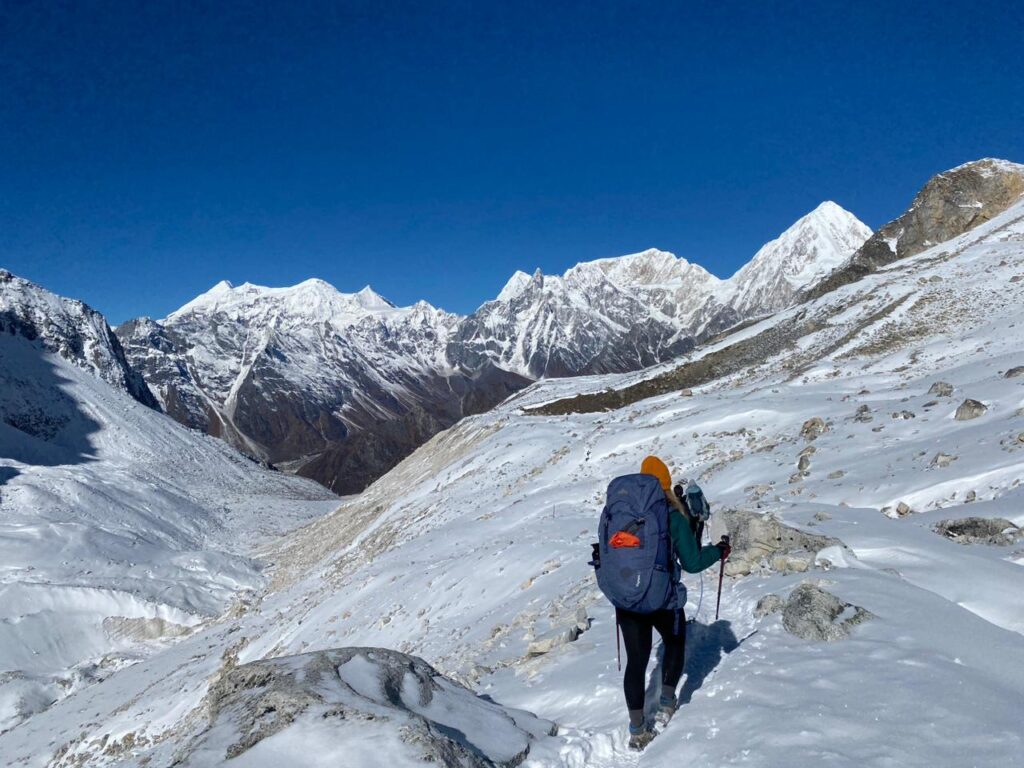
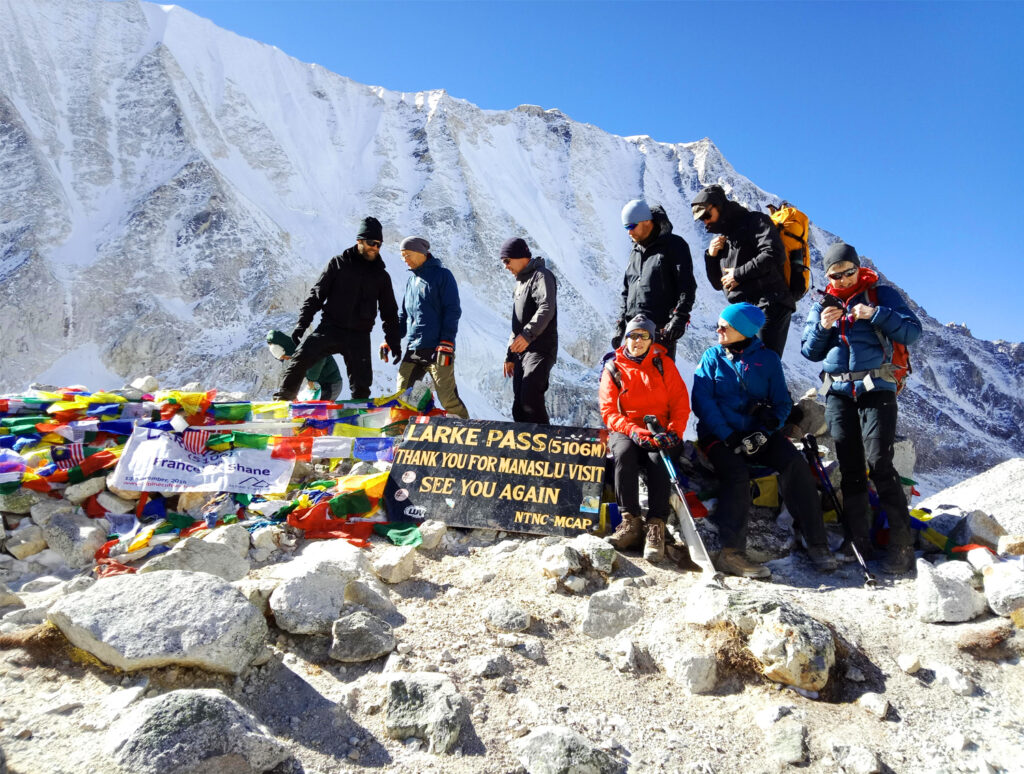
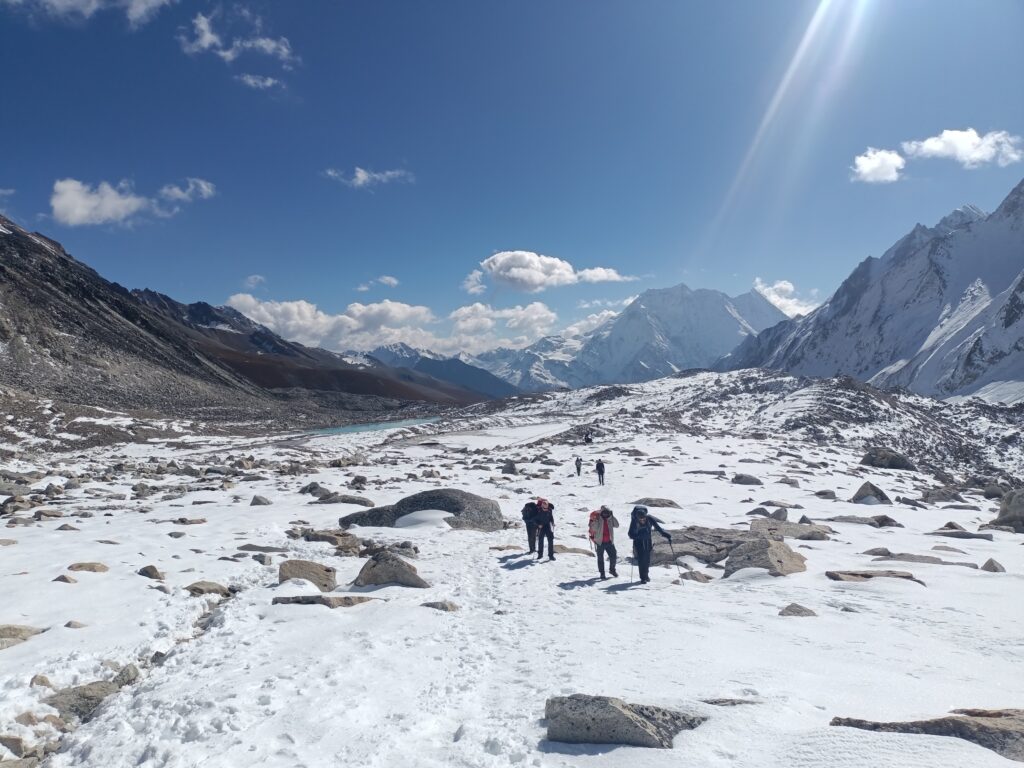
We start early today for the challenging ascent to Larkya La Pass, at 5,106 meters. This strenuous climb is rewarded with breathtaking views of the surrounding peaks and valleys. As we ascend, panoramic vistas of Mt. Manaslu, Larkya Peak, Bouddha Himal, Himalchuli, and Peak 29 unfold around us, creating an awe-inspiring backdrop. Upon reaching the top, adorned with fluttering Buddhist prayer flags, we take a moment to soak in the stunning landscape and sense of achievement.
From here, we begin a steep and often slippery descent to Bimthang village, passing through rugged trails that require careful footing. Crampons and trekking poles are highly recommended for this portion, especially as we navigate icy sections. As we descend, the landscape gradually shifts, and we arrive in the tranquil village of Bimthang, nestled in a magnificent valley. We’ll spend the night here, surrounded by towering peaks and the peaceful ambiance of the high mountains.
Day 13 Bhimtang to Dharapani
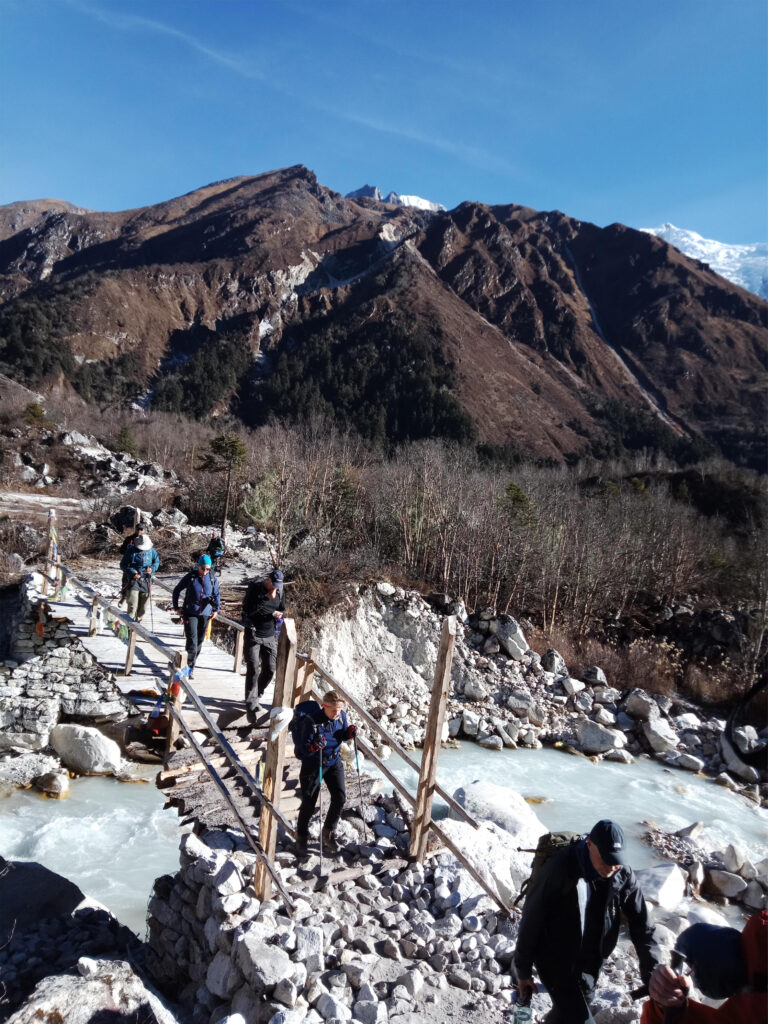
This is your final day trekking through the scenic Manaslu region. Descending from Bimthang, you’ll journey through lush forests rich with flora and fauna, including vibrant rhododendron bushes. The trail crosses the Dudh Khola and leads you to Karche, where you’ll pause for lunch amidst the natural beauty.
An hour after lunch, signs of past glacial floods appear, with scattered tree trunks and eroded riverbanks, making the path a bit rugged. The trail then descends to the charming Gurung village of Goa, the first settlement since Samdo. As you continue, the valley becomes increasingly fertile, with agricultural fields, oak groves, and vibrant rhododendron forests lining the path. Following the north (true right) bank, you’ll reach Tilije before your final stretch to Dharapani. This final walk is a blend of natural beauty and rural charm, providing a perfect end to your memorable trek.
Day 14 Dharapani to Kathmandu
After an early breakfast, we’ll embark on a scenic 3-hour journey to Besisahar in a local shared jeep, traveling through forested hills and picturesque villages. Once we reach Besisahar, we’ll begin our drive back to Kathmandu, which takes approximately 6-7 hours along winding mountain roads. For a more comfortable and flexible experience, we highly recommend arranging a private vehicle for the journey from Besisahar to Kathmandu. Upon arrival in the vibrant city, our memorable adventure officially concludes. We’ll part ways in Kathmandu, carrying unforgettable memories of the incredible landscapes and cultural experiences we’ve shared along the trail.
Day 15Final Departure: Transfer to the Airport
On the day of your departure, we will arrange a seamless transfer to Tribhuvan International Airport (TIA), ensuring you reach on time and with ease. As you bid farewell to Nepal, we wish you a safe and pleasant journey ahead, filled with wonderful memories of your adventure.
Price Includes
- 3 times (Full board) meal per day during the trek
- Seasonal Fruits
- Tea house accommodation during the trek (twin shared accommodation)
- All land transportation as per itinerary (Kathmandu to Machha Khola and Dharapani to Kathmandu by local bus)
- A professional government licensed trekking guide
- All required permits (Restricted area permit, TIMS, Manaslu Conservation Area Permit, and Annapurna Conservation Area Permit)
- Travel and rescue arrangements only
- Duffel bag to carry your equipment and trekking map
- All necessary paper works
- Farewell dinner
- Basic medical kit
- All government and local taxes
Add-ons
- A porter (A porter can carry up to 15 – 20 kg – 1 porter for 2 trekkers)
- Private jeep (Kathmandu to Soti Khola drive)
- All airport-hotel transfers
- Boutique hotel accommodation in Kathmandu with breakfast included (Optional:4-star hotel)
Price doesn’t Include
- International airfares
- Lunch and Dinner in Kathmandu
- Tips for guide and porter
- All additional costs (such as beverages, shopping, etc)
- Travel and rescue insurance
- All the things not mentioned in the inclusion
Alternatives treks to Manaslu Circuit Trek in Manaslu Region
Manaslu circuit trek offers a remarkable experience for every adventurer as it passes through the 8th highest Mountain Manaslu (8163m). It combines the amazing mountain ranges with diverse flora and fauna along with rich cultural and archaeological sites. Around Manaslu Trek often called Manaslu Circuit Trek is one of the most popular treks which encircles Mt. Manaslu. During the trek, trekkers are gifted with a wide variety of stunning mountain sceneries as well as Tibetan origin culture.
Concerning Manaslu’s historical and cultural aspects, the government has issued a special permit for foreigners to visit this area. Foreigners must issue permits from the Department of Ministry. Mainly, Autumn and Spring are the best seasons and busiest times in Nepal. So booking the Manaslu trek earlier means securing a place on tour in Manaslu.
List of alternatives treks to Manaslu Circuit Trek in Manaslu Region:
Best Time to Trek Manaslu Circuit
There are four distinct seasons for trekking in the subtropical Nepal Himalayas: spring, autumn, winter, and summer, each offering its own unique experience.
Spring (March to May):
Spring is one of the best seasons for trekking in Nepal, particularly the Manaslu Circuit. The weather is warm, and the hillsides are bursting with colorful wildflowers, including blooming rhododendrons. The trails offer clear mountain views, and the temperatures are moderate, making for comfortable trekking conditions. Spring also marks the climbing season, so you may encounter mountaineers preparing for expeditions. However, as it’s a popular time, the trails can be busy.
Autumn (September to November):
Autumn is the most popular season for trekking in Nepal, thanks to its stable weather and clear skies. After the monsoon rains, the air is crisp and fresh, offering some of the clearest mountain views of the year. Temperatures are mild during the day and cooler at night, ideal for trekking. This is the peak trekking season, so expect more people on the trails, but the experience of trekking in such perfect conditions makes it worthwhile.
Winter (December to February):
Winter trekking in Nepal is much quieter and offers a more peaceful experience. While it does get colder, especially at higher altitudes, the lower number of trekkers means you can enjoy the solitude of the mountains. Nepal’s winter isn’t as harsh as in countries like Canada or northern Europe, and the skies are often clear, providing great mountain views. However, some high-altitude passes may be blocked by snow, so it’s important to plan your trek accordingly.
Summer (June to August):
Summer in Nepal coincides with the monsoon season, bringing heavy rains, especially in lower altitudes and forested areas. The trails can be muddy and slippery, and the mountains are often shrouded in clouds. However, this is the least crowded season, and the landscapes are lush and green. Some trekkers still venture out during this time, particularly to rain-shadow areas like Upper Mustang or Dolpo, which are drier and offer more favorable conditions. For those trekking the Manaslu Circuit in summer, be prepared for leeches and frequent rain showers, but you’ll also experience a quieter and more verdant trekking environment.
Each season in the Nepal Himalayas has its own charm, making trekking possible year-round depending on your preferences and tolerance for different weather conditions.
Food and Accommodation in Manaslu Circuit Trek
You will be served a full board basis meal, but only breakfast is provided while in Kathmandu. During the trek, 3 times meals (breakfast, lunch, and dinner) with one cup of tea/coffee will be served from tea houses. Every day, dinner and breakfast will be served at the same tea house where we stay overnight, while lunch will be taken in the tea house on the way to the trek. Please note there may not be a variety of foods as the region is not well established like the Annapurna and Everest region. You will usually have Tibetan bread, Dal-Bhat, Tsampa porridge, and other local foods.
While trekking the Manaslu Circuit, you will primarily be served Dal Bhat Tarkari, a typical Nepali meal, for lunch and dinner. The food options are somewhat limited compared to the more frequented Everest Region due to fewer teahouses and a smaller variety of available dishes.
For breakfast, you can expect to find options such as Tibetan bread served with honey or jam, porridge with local honey, or eggs prepared to your liking (boiled, fried, or scrambled) accompanied by chapati or toast.
Lunch often mirrors dinner with Dal Bhat being a common staple, but you may also find noodle soups like Thukpa, which are particularly comforting in cooler weather. Despite the limitations, the meals provided are nourishing and fitting for the trekking experience, ensuring you have the energy needed to explore this beautiful region.
Please read the following article to know the suggested food to eat while on the Manalsu trek.
Note:
As you arrive in Kathmandu, you will be welcomed and picked up, then transferred to a Hotel if you order airport pick-up service. You stay in a hotel in Kathmandu. Several types of hotels can be found in Kathmandu. 5-star levels to boutique hotels and homestay are available to stay overnight. However, we normally provide a boutique hotel with breakfast included. Each member will get a separate room. While you are trekking, you are provided tea house accommodation as there is no luxurious hotel or lodges in the Manaslu region. So the trek is also called a tea house trek. In fact, you can not find a deluxe hotel in the Nepal Himalayas.
Manaslu Circuit Trek Difficulty (Altitude Sickness, Acclimatization, and Training)
All trekking routes in the Manaslu region reach up to 5,106 meters in altitude at Larkya La Pass, which can cause altitude sickness. While crossing Larkya La Pass, you may encounter altitude sickness. Therefore, before embarking on your Manaslu circuit trek, it is essential to understand its symptoms and the process of acclimatization. Note that although all the trekking in Manaslu is moderate, it can be quite strenuous. Nevertheless, a trekker aged between 58-65 years can successfully complete this trek with proper acclimatization.
Manaslu circuit trek often requires at least 5-6 hours of walking every day. Whereas, you also need to walk 8-9 hours on some days that including walking in Larkya la pass. Therefore, we suggest you get prepared with walking or jogging exercises every day 3 months prior to the trip. Then, you will be able to walk in physically demanding high altitude and remote places. To enjoy this trip, you should bring willpower and the ability to tolerate harsh conditions.
For detailed information, check out the Manaslu Circuit Trek difficulty.
Travel and Trekking Insurance for Manaslu Circuit Trek
Travel and trekking insurance is mandatory for the Manaslu Circuit Trek. While the risk of injury on the Manaslu circuit trek is relatively low, it is essential to have comprehensive insurance to cover medical expenses and emergency helicopter rescue costs in case of an unforeseen incident.
Your insurance should specifically cover a maximum altitude of up to 6,000 meters. Although high-altitude coverage is not typically included in standard travel insurance policies, it must be added separately. For more information on travel insurance, read “Travel Insurance for Trekking in Nepal” and also check out the article “Helicopter Rescue Scam” for additional insights.
Is travel insurance mandatory for Manaslu Circuit Trek?
Yes, travel insurance is mandatory for the Manaslu Circuit Trek. Due to the remote and challenging nature of the trek, it is crucial to have comprehensive insurance that covers high-altitude trekking, medical emergencies, evacuation, and trip cancellations. Ensure that your policy covers trekking up to 5,000 meters and includes helicopter evacuation services. This will not only ensure your safety but also provide peace of mind throughout your adventure.
Manaslu Circuit Trek – Packing lists/Trekking Gears
The packing list for Manaslu Circuit Trek differs in different seasons, which includes some important items. Trekking gears like Down Jacket, Sleeping bag, Hiking boots, Trekking Poles, Trousers, Sunglasses, T-shirts, Hiking socks etc are mostly required for the trip. Some of the items can be rented. But we suggest some personal things that you should bring with you to Nepal.
Check out a complete packing list for Manaslu ciruit trek to get detail about the trekking gears.
Necessary Permit for Manaslu Circuit Trek
Foreigners need 3 different permits to trek Manaslu. The permits are Restricted Area Permit, Manaslu Conservation Area Permit, and Annapurna Conservation Area Permit. Moreover, it needs a special restricted permit, which requires at least 2 trekkers and a local guide. It is mandatory for restricted area like Manaslu, Upper Mustang, Upper Dolpo Trek etc.
For detail go to Manaslu Circuit Trek Permits – Requirement and Fees
Manaslu Circuit Trek Transportation
Nowadays, local buses provide easy access to Soti Khola and Machha Khola, where the trek begins. Alternatively, you can choose a private vehicle, such as a jeep or Hiace, or opt for a shared jeep for a more comfortable ride.
Local buses take approximately 9 hours to reach Machha Khola. While this is a more budget-friendly option, it can be quite crowded, with fares around 1500 Nepalese rupees per person. On the other hand, private jeeps offer greater comfort and flexibility. They can be arranged through travel agencies or hotels and typically reach Machha Khola in about 7 to 8 hours. However, this option is more expensive, costing up to 220 USD.
Transportation Options We Provide
Beginning of the Manaslu Circuit Trek: You should follow the above itinerary. In the beginning, you need to travel to Machha Khola from Kathmandu via Soti Khola. It takes nearly 8/9 hours or 7/8 hours by local bus and private jeep respectively.
Ending of the Manaslu Circuit Trek: You will also complete your trip by driving back to Kathmandu. From Dharapani, you will return to Besisahar by shared jeep and then change to a local bus for a 7-8 hours Kathmandu drive.
Communication Medium in Manaslu Circuit Trek
Now Internet WiFi service is available in most of the teahouses. You also can get SAT phone to communicate with your friends and families paying a certain amount of charge. But local telephone hardly works in this region. Mobile networks (NTC and NCELL) do also provide coverage in this region.
Trekking Map
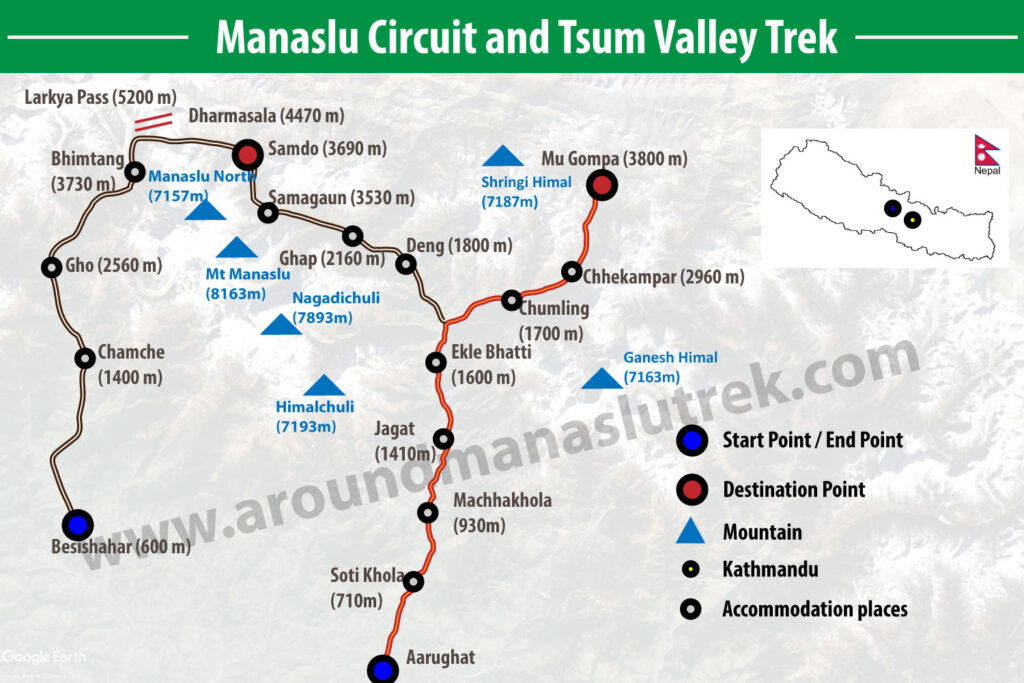
Tourist Visa Information for Manaslu Circuit Trek
All foreigners except Indian nationals require a visa to visit Nepal. Citizens of some countries like SAARC (South Asian Association for Regional Cooperation) countries and China do get free visas upon arrival in Nepal. However, the rest of the world’s people must issue visas to enter Nepal. You can easily get an arrival visa at Tribhuvan International Airport. You just require to have a passport with at least 6 months validity, a PP-size photo, and a visa fee, then you will get the visa in Nepal. As of now, the visa fee is $50 USD for 30 days which you can pay in cash.
There are a few countries like Ghana, Zimbabwe, Nigeria, Cameroon, Swaziland, Somalia, Liberia, Ethiopia, Iraq, Palestine, and Afghanistan; the citizen of these countries do not receive an on-arrival visa. They have to contact the embassy of Nepal or the nearest consulate.
Most foreign travelers can obtain a visa on arrival at Tribhuwan International Airport in Kathmandu, Nepal, provided their passport is valid for at least six months. Currently, both arrival and departure online applications must be submitted prior to your flight. For the latest regulations, please visit the official Nepal Immigration website: Nepal Immigration.
Manaslu Circuit Trek Gallery
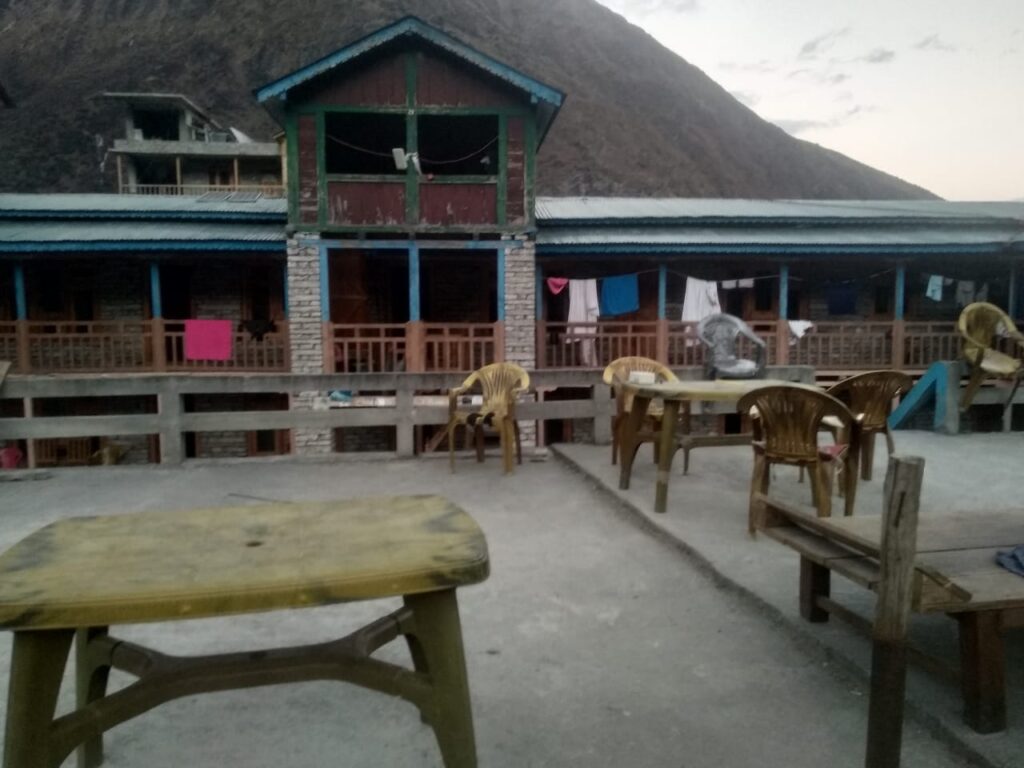
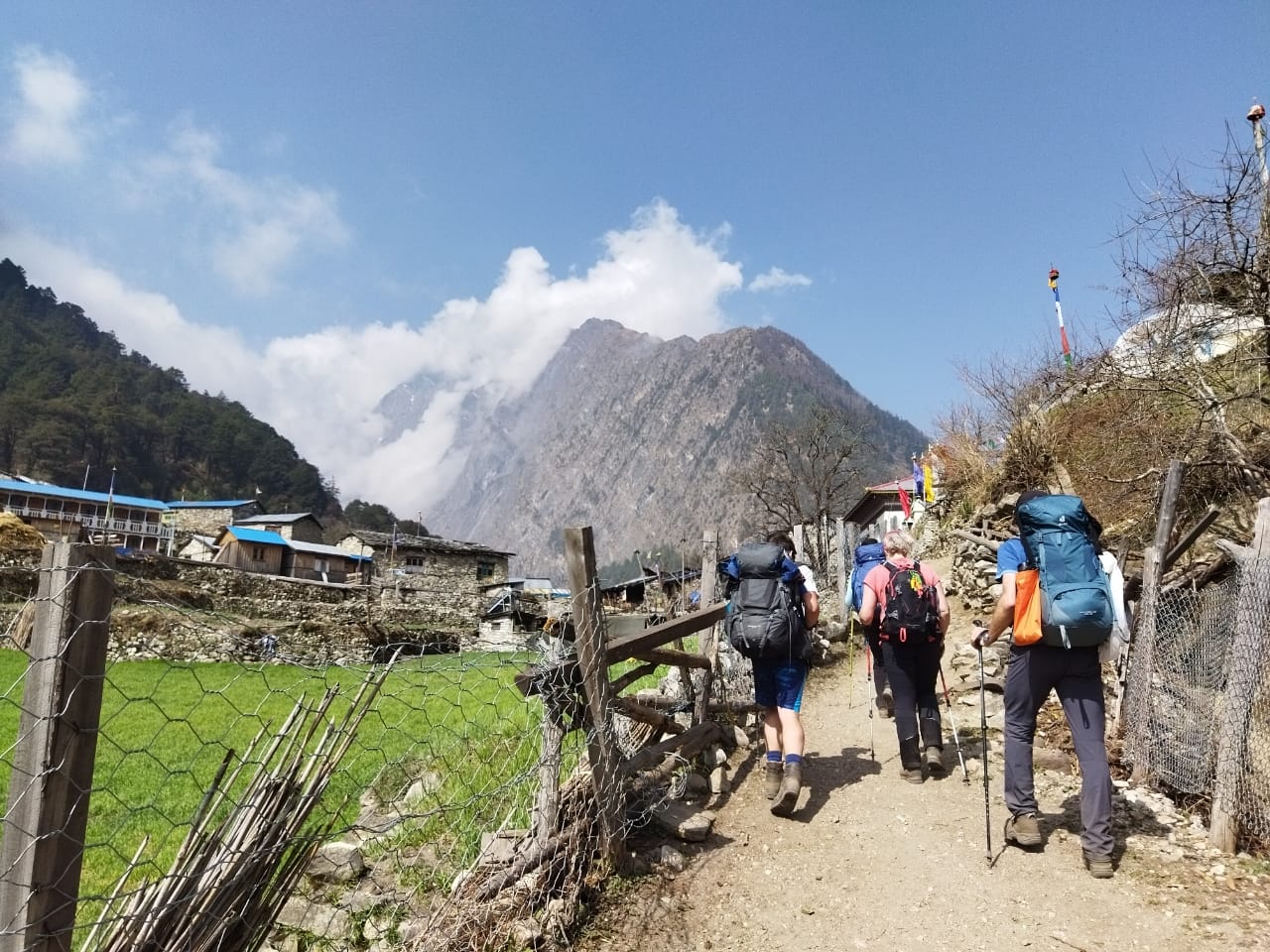
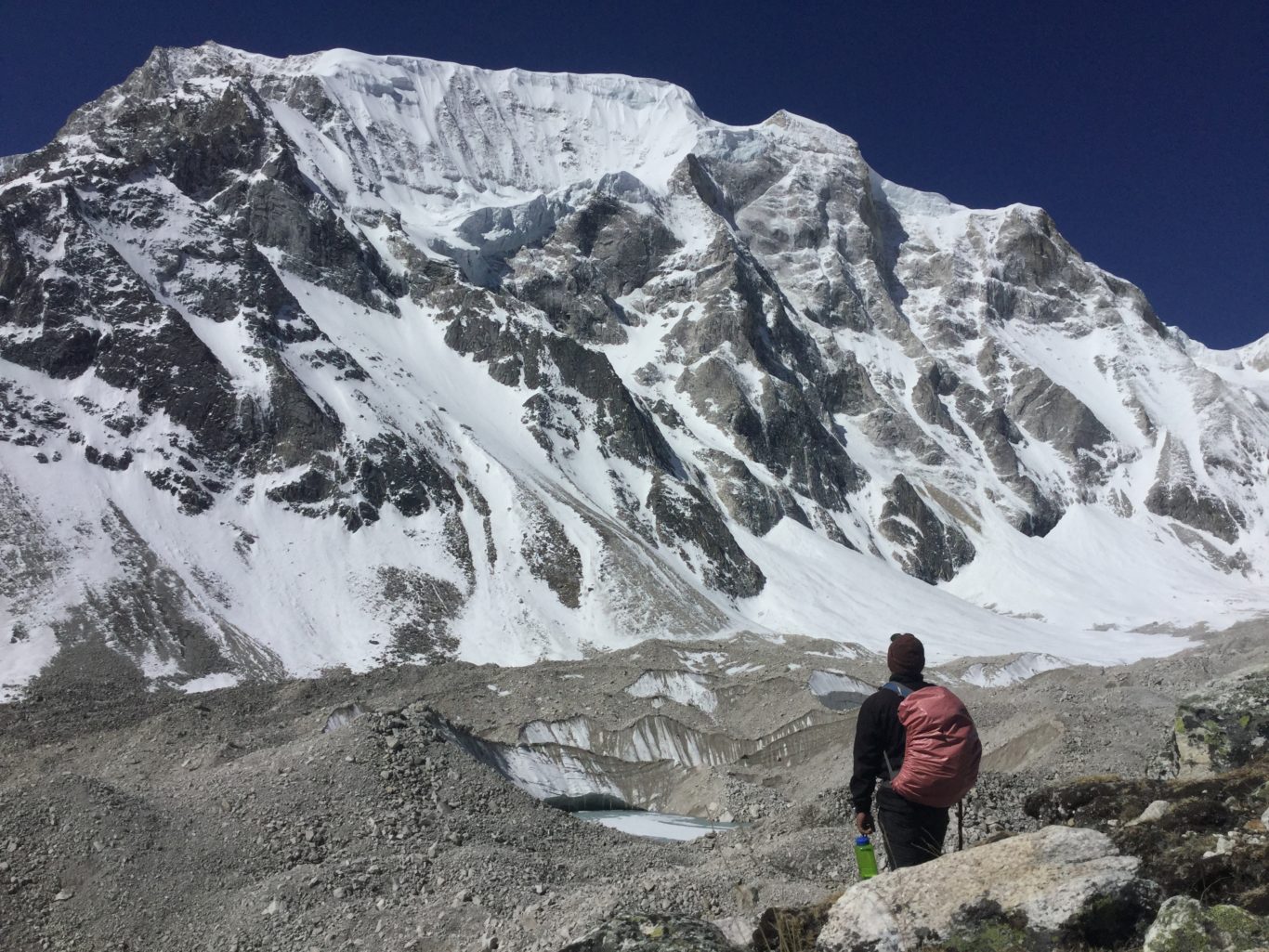

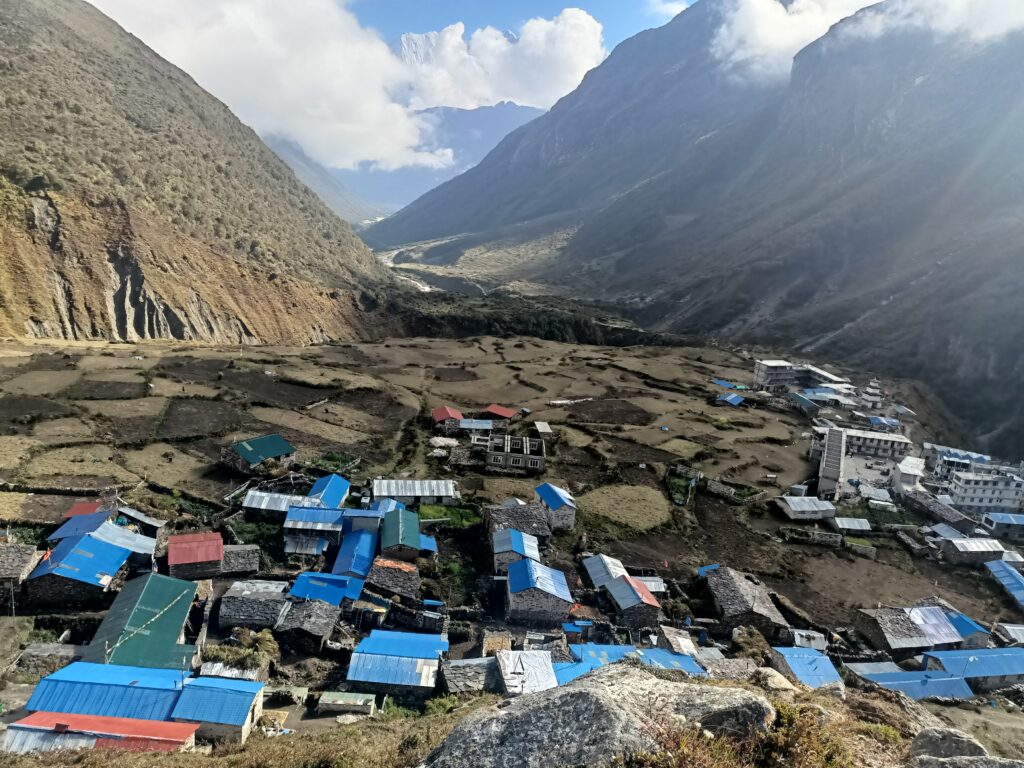
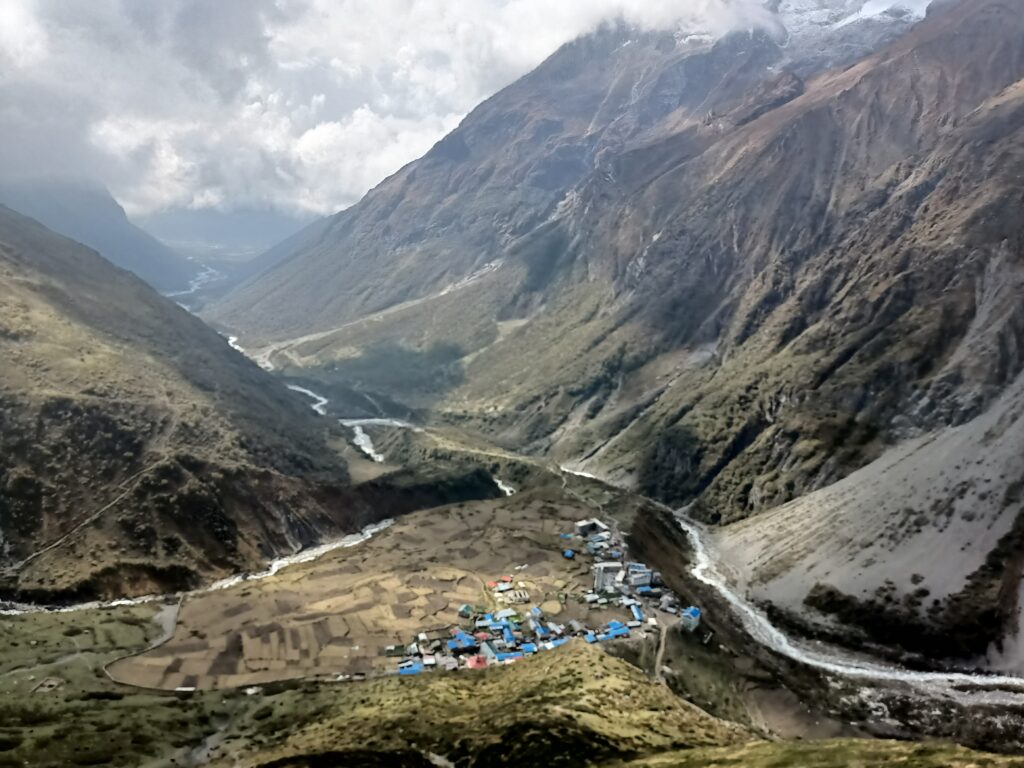
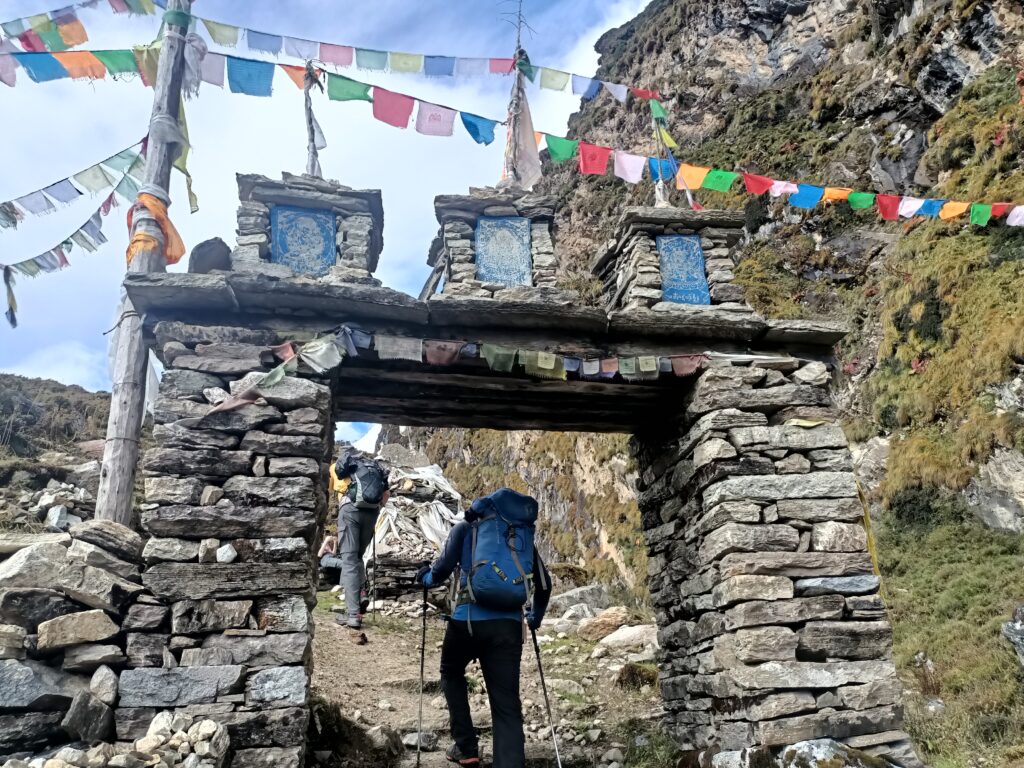
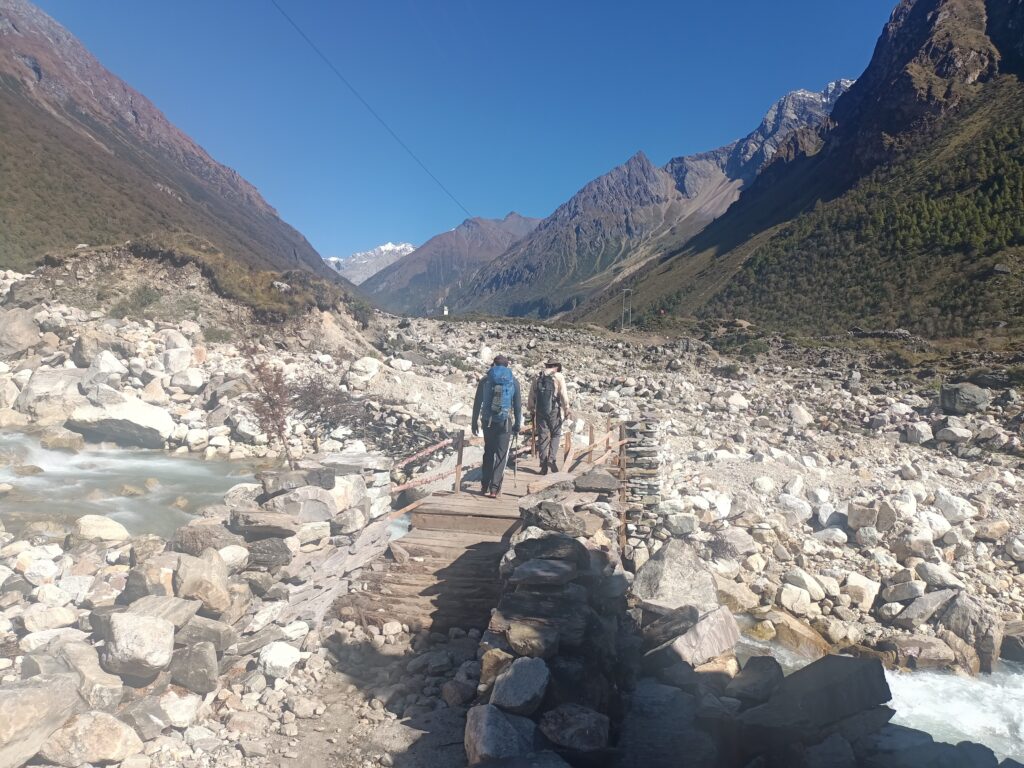

Notes:
- We are determined to operate trekking on fixed departure dates despite a single-person booking.
- You can request your own group departure date, we will help you to find your trekking partner. Or we also operate private trip.
Fixed Departure Dates and Cost for 2025
| Departure Dates | Duration | Availability | Action |
|---|---|---|---|
| March 3, 2025 | 12 Days | Available | Book Now |
| March 9, 2025 | 12 Days | Available | Book Now |
| March 15, 2025 | 12 Days | Available | Book Now |
| March 21, 2025 | 12 Days | Available | Book Now |
| March 27, 2025 | 12 Days | Available | Book Now |
| April 5, 2025 | 12 Days | Available | Book Now |
| April 11, 2025 | 12 Days | Available | Book Now |
| April 17, 2025 | 12 Days | Available | Book Now |
| April 23, 2025 | 12 Days | Available | Book Now |
| April 29, 2025 | 12 Days | Available | Book Now |
| May 5, 2025 | 12 Days | Available | Book Now |
Note: We also operate private trip as well.
FAQs of the Manaslu Circuit Trek
How much does Manaslu Circuit Trek Cost?
To get detailed information about it, look at our article titled Manaslu Circuit Trek cost.
Can I trek to Manaslu without a guide and porter?
No, you can’t trek to Manaslu without a guide but without a porter it is possible. As per the rule of the government of Nepal in order to visit a restricted area, one should have a special permit. So, you need to issue a special permit to trek to Manaslu, whereas a special permit can not be issued without a guide. Hence, foreigners can not visit Manaslu without a guide.
How far is Manaslu from Kathmandu?
The trekking point of Manaslu is nearly 126 km far from the capital Kathmandu. However, it is about 123 km of aerial distance from Kathmandu valley.
How do I reach Manaslu from Kathmandu?
You either choose a local bus or a private vehicle to reach Manaslu. There is no fly route or waterways to reach Manaslu. It takes around 8 hrs to get there by local or private vehicle.
Where is Manaslu located?
Manaslu is located northwest of Kathmandu bordered by the Annapurna region in the west and Langtang Ganesh Himal in the east.
Is Manaslu Circuit Trek better than Annapurna Circuit Trek?
Indeed, both are separate trails! Annapurna Circuit comes with a fantastic landscape and view of spectacular high mountains encircling Mt Annapurna while Manaslu Circuit offers Tibetan-like culture and tradition along with a beautiful view of Mt Manaslu, Ganesh Himal, Buddha Himal, and more. Annapurna Circuit Trek is not as same as it was before because of the road construction. However, it has shortened the trekking duration. Now, you can directly drive to Manang Village via Jeep but the road is too dangerous and muddy. On the other hand, Manaslu Circuit Trek Trail is intact though there is ongoing road construction. It is still considered to be an off-the-beaten-track as it is a less visited region in comparison to the other areas.
How is the climate in the Manaslu region?
Manaslu region covers both subtropical to tundra climates ranging from a hilly area to a high mountain area. So, 10 to 25 degree Celsius temperature could be expected throughout the year while it may fall to -22 degree Celsius and below in the upper parts of the Himalayas.
Is Manaslu Helicopter Tour possible like Everest Base Camp Helicopter Tour?
Of course, it is possible and open to fly to Manaslu by Helicopter. Manalsu Helicopter Tour is for those travelers who want to take the advantage of exploring most of the areas of the Manaslu region in a short amount of time. This tour is optimal for those who are physically unable to trek to Manaslu Circuit. It offers marvelous views of mountains from a close distance.
Is natural water drinkable on the Manaslu Circuit Trek?
Although the flowing water in mountain areas may appear very clear, we strongly advise against drinking tap water or any water from natural streams. To make it safe for consumption, you should use a water purifier or boil the water.
What is the highest altitude of the Manaslu Circuit Trek?
Larkya La Pass is the highest point of this trek which is elevated at 5106 m above sea level.
Should I choose Tsum Valley or only go to Manaslu Circuit Trek?
Tsum Valley is a distinct valley because of its culture and traditions. The tradition and culture of Tsum valley is similar to the Tibet. In addition, polyandry system still exists in this valley. So, if you want to explore its culture tradition and the beauty of nature, then you can add Tsum valley in your bucket list if you are planning to trek Manaslu.
Is it possible to comeback to Kathmandu by Helicopter from Manaslu Base Camp?
Of course, it is possible to fly back to Kathmandu by Helicopter from the base camp of Manaslu. However, you need to inform us 2 days earlier to manage the helicopter or the itinerary plan should be made before the trip starts.
Is Larkya Pass difficult for beginner trekkers?
Larkya Pass is situated at an altitude of over 5106m above sea level, making it a delightful pass located in the Manaslu region. The pass is not too high, so trekking in the spring and autumn seasons may not be too challenging. However, if you wish to cross this pass in the winter season, it can be difficult because it may be covered with a full layer of snow at that time. The well-trained team of Around Manaslu Trek will ensure your trek is comfortable and successful while you are exploring the Manaslu region.
Which peak is the highest mountain in the Manalsu region?
Mt. Manaslu, standing at 8163m, is the highest peak in the Manaslu region and the 8th highest mountain in the world.
Does credit card work in Manaslu region?
There is no access to credit cards in the region because it is so rural, despite its proximity to the capital, Kathmandu. You will not find any ATMs or POS services in the Manaslu region. Therefore, you should withdraw the required cash from Kathmandu before starting the trek
Do you customize the Manaslu Circuit Trek?
Yes, we do customize the Manaslu Circuit Trek. Although we have a fixed departure dates for a generic itinerary of 12 days Manaslu Circui Trek, we are also flexible to customize the trip as your budget, plans, and schedules.
Do I need oxygen for Manaslu Circuit Trek?
No, it is not needed for most of the cases during the trek. But if you need, then some of the teahouses contains oxygen cylinder for the emergency cases.
Is this trek suitable for children and pregnant woman?
Children can trek to Manaslu as long as they are physically fit. However, it is not recommended to do this trek for Pregnant women.
Who will pickup me at airport?
A representative from the Around Manaslu Trek Team will be at the airport to pick you up and take you to your hotel.
Can I do Manaslu Circuit Trek alone?
No, you are not allowed to trek alone in the Manaslu Valley. The Manaslu region is a restricted area, and regulations require a minimum of two people in a group to obtain a special permit. A single person cannot issue this permit on their own.
What is the cost of Manaslu Circuit Trek Permit?
The cost of the Manaslu Circuit Trek permit varies based on the season and duration of your trek between Jagat and Dharapani:
September to November:
USD 100 per person for the first seven days.
USD 15 per person per day from the eighth day onwards.
December to August:
USD 75 per person for the first seven days.
USD 10 per person per day from the eighth day onwards.
Additionally, after crossing the Larkya La pass, you will need an Annapurna Conservation Area Project (ACAP) permit. These permits are necessary to ensure the conservation and management of the areas you’ll be trekking through.
How much altitude do we gain during the Manaslu Circuit trek ?
During the Manaslu Region trek, you gain altitude up to approximately 5,106 meters (16,781 feet) at the Larkya La Pass, which is the highest point of the trek.
How far is the Tibetan border from Samagaun, Manaslu?
The Tibetan border is approximately 15-20 kilometers (9-12 miles) from Samagaun (also spelled Samagaon) in the Manaslu region of Nepal. The journey to the border typically involves crossing the Larkya La Pass, which is part of the Manaslu Circuit Trek, and can be challenging due to the high altitude and rugged terrain.
How long does it take to hike Manaslu?
The duration of the Manaslu Circuit Trek varies depending on the specific route and itinerary you choose. Typically, it takes a minimum of 12 days to complete the trek. However, if you wish to thoroughly explore the region’s natural beauty and cultural heritage, including a visit to the Tsum Valley, it can take up to 18 days.
Why to trek Manaslu Circuit Trek with us?
Choosing the right trekking company can significantly enhance your Manaslu Circuit trek experience. Here are compelling reasons to consider trekking the Manaslu Circuit with us:
Expert Local Guides
Our team comprises experienced local guides who are not only well-versed in navigating the Manaslu Circuit but are also deeply familiar with the local culture, history, and environment. Their expertise ensures you have a safe, informative, and enriching trekking experience.
Tailored Itineraries
We understand that every trekker has unique needs and preferences. That’s why we offer customizable itineraries that can be adjusted to match your fitness level, interests, and time constraints, ensuring you get the most out of your Manaslu circuit trek.
Small Group Sizes
To enhance your trekking experience and ensure personalized attention, we maintain small group sizes. This approach fosters a closer group dynamic, allows for more interaction with your guide, and minimizes our impact on the environment and local communities.
Sustainable Trekking Practices
We are committed to sustainable tourism practices that protect the environment and contribute positively to local communities. By trekking with us, you’re supporting eco-friendly practices and helping promote economic benefits for the local people.
Comprehensive Support
From the moment you book your trek to the day you complete your journey, our team provides comprehensive support. This includes pre-trek preparation advice, assistance with obtaining necessary permits, and ensuring you have the right gear and information for a successful trek.
Safety First
Your safety is our top priority. Our guides are trained in first aid and emergency response, and we conduct our treks with the utmost care, including regular weather and trail condition checks. We also ensure that our treks are conducted in accordance with the latest safety standards and protocols.
Cultural Immersion
Our treks are designed not just as physical journeys but as cultural experiences. We provide opportunities to interact with local communities, participate in traditional customs, and learn about the rich cultural heritage of the Manaslu region, offering a deeper connection to the places you visit.
Quality Equipment and Accommodations
We provide high-quality camping equipment for treks that require it and select the best available teahouses for your comfort. Our aim is to ensure that your nights are as enjoyable and comfortable as your days on the trail.
Competitive Pricing
We offer competitive pricing without compromising on the quality of our services. Our packages are all-inclusive, covering permits, accommodation, meals on the trek, and transportation, ensuring you get great value for your investment.
Choosing to trek the Manaslu Circuit with us means commencing on an unforgettable journey that is safe, enjoyable, and deeply connected to the natural beauty and cultural richness of the Himalayas. Our commitment to excellence, sustainability, and the well-being of our clients makes us the ideal partner for your Himalayan adventure.
